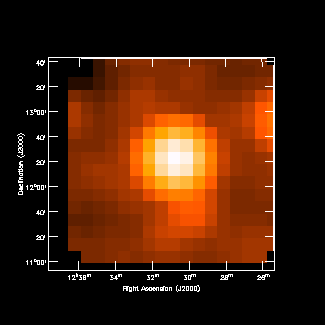
GBT News Update
21 February 2001
Last week's commissioning activities concentrated on pointing and focus observations at 800 MHz with Prime Focus Receiver 1. In addition to characterizing the receiver and antenna properties, the observations were also an opportunity to test servo and control software, as well as AIPS++ data reduction software. It was a successful and productive week. Both axial and lateral focus curves have been measured and agree very nicely with theoretical predictions. Although a pointing model has not yet been fit, the telescope is pointing to within 2 arcminutes. A preliminary measurement of the 800 GHz aperture efficiency has been estimated at 70%, which is the expected value in the long wavelength limit of the GBT. A beam map was measured on Virgo A (790 MHz). An amplifier saturated at the peak response of the source and prevented an accurate scale from being set, but the map showed qualitatively that sidelobe levels are very low. The beam map image appears below.

790 GHz Beam Map of Virgo A. The map was made with 1 second per point integrations, which reaches the confusion limit at this frequency. The display is logarithmic, and despite the fact that it is saturated, shows that the sidelobes are below -15 dB. The data were reduced with AIPS++.
Other activities last week included installation of the Ku- and K-band feeds, work on the L-band receiver in the lab to eliminate a noise resonance, and installation of fiber optic cable from the ring of ground laser rangefinders to various points on the telescope.
Over the next few days, the pointing, focus, and beam mapping observations will be repeated, and a pointing model will be fit. Toward the end of this week, commissioning tests will shift to the Gregorian S-band receiver.
P. R. Jewell
M. M. McKinnon